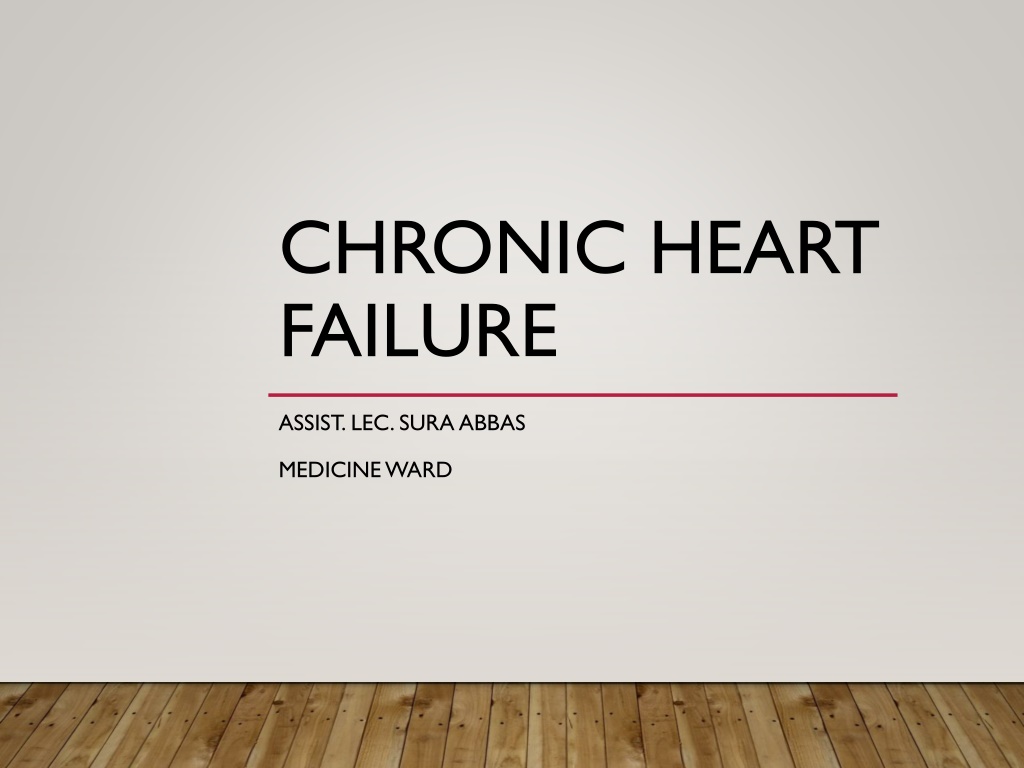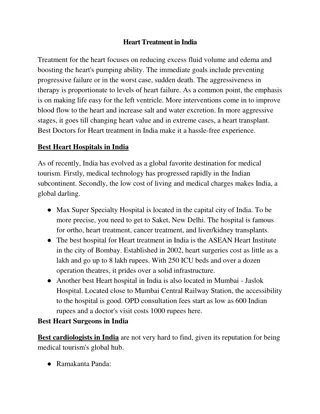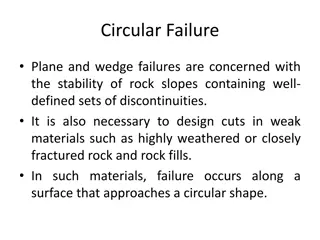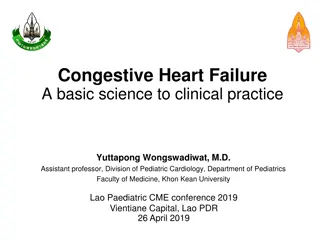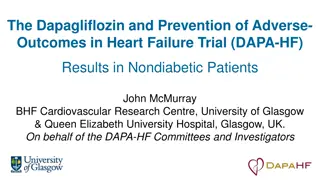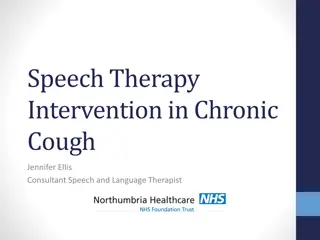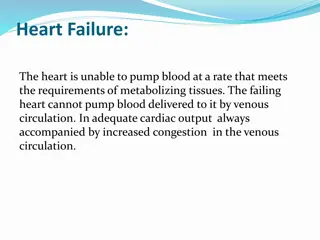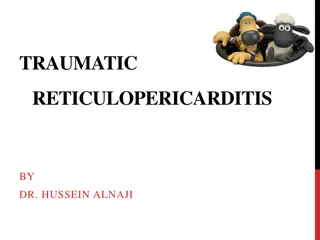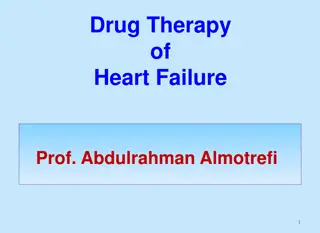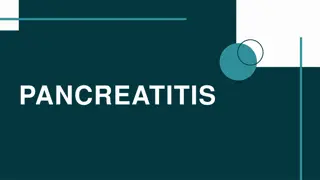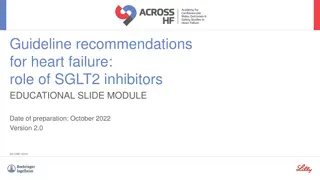Understanding Chronic Heart Failure: Causes, Symptoms, and Treatment
Chronic heart failure is a serious condition caused by various factors such as coronary artery disease, hypertension, and cardiomyopathy. It involves both left-sided and right-sided symptoms, impacting quality of life and survival. Treatment aims to manage symptoms, slow disease progression, and improve survival through a combination of pharmacologic and nonpharmacologic interventions.
Download Presentation

Please find below an Image/Link to download the presentation.
The content on the website is provided AS IS for your information and personal use only. It may not be sold, licensed, or shared on other websites without obtaining consent from the author. Download presentation by click this link. If you encounter any issues during the download, it is possible that the publisher has removed the file from their server.
E N D
Presentation Transcript
CHRONIC HEART FAILURE ASSIST. LEC. SURAABBAS MEDICINE WARD
QUICK REVISION The most common causes of heart failure are coronary artery disease (CAD),hypertension,and dilated cardiomyopathy. The sympathetic nervous system and the renin-angiotensin aldosterone system (RAAS) involved in disease progression. Symptoms of left-sided heart failure include dyspnea, orthopnea, and paroxysmal nocturnal dyspnea (PND), whereas symptoms of right-sided heart failure include fluid retention, GI bloating, and fatigue.
Agents with proven benefits in improving symptoms, slowing disease progression, and improving survival in chronic heart failure target neurohormonal blockade; these include angiotensin-converting inhibitors or angiotensin receptor blockers (ARBs), adrenergic blockers, and aldosterone antagonists. enzyme (ACE)
NYHA FUNCTIONAL CLASSIFICATION OF CHRONIC HEART FAILURE According to the classification the patient will be treated
Treatment of chronic heart failure DesiredTherapeutic Outcomes There is no cure for HF. The general therapeutic management goals for chronic HF include: preventing the onset of clinical symptoms or reducing symptoms preventing progression of the disease, improving quality of life, and prolonging survival. or reducing hospitalizations, slowing
Nonpharmacologic interventions Non pharmacologic treatment involves dietary modifications such as sodium and fluid restriction, risk factor reduction including smoking cessation, timely immunizations, and supervised regular physical activity. Patient education (monitoring symptoms, dietary and medication adherence, exercise and physical fitness) Home assessment of weight and exercise tolerance. monitoring should include daily
Pharmacologic treatment Diuretics Diuretics are used for relief of acute symptoms of congestion and maintenance of euvolemia. In more milder HF, diuretics may be used on an as-needed basis. However, once the development of edema is persistent,regularly scheduled doses will be required.
Therapeutic options Two types of diuretics are used for volume management in HF: thiazides and loop diuretics. Thiazide hydrochlorothiazide, chlorthalidone, and metolazone. diuretics such as Thiazides are optimally suited for patients with hypertension congestion who have mild
Diuretic resistance The maximal response to diuretics is reduced in HF, creating a ceiling dose above which there is limited added benefit. This diuretic resistance is due to a compensatory increase in sodium reabsorption in the distal tubules, which decreases the effect of blocking sodium reabsorption in the loop of Henle strategies to improve diuretic efficacy include increasing the frequency of dosing to two or three times daily,utilizing a continuous infusion Metolazone can be dosed daily or as little as once weekly. This combination is usually maintained until the patient reaches his or her baseline weight.
Diuretics side effects Diuretics abnormalities, with severity linked to diuretic potency. A particularly worrisome adverse effect in the setting of HF is hypokalemia. cause numerous adverse effects and metabolic Low serum potassium can predispose patients to arrhythmias and sudden death. Hypomagnesemia often occurs concomitantly with diuretic- induced hypokalemia, and therefore both should be assessed and replaced in patients needing correction of hypokalemia.
Neurohormonal blocking agents ACE inhibitors ACE inhibitors are also effective in preventing HF development in high-risk patients All dysfunction, regardless of existing HF symptoms, should receive ACE contraindication or intolerance is present. patients with documented LV systolic inhibitors unless a
Role of ACEI in MI Studies in acute MI patients show a reduction in new-onset HF and death with ACE inhibitors whether they are initiated early (within 36 hours) or started later. In addition, ACE inhibition decreases the risk of HF hospitalization and death in patients with asymptomatic LV dysfunction
Contraindications of ACEI Absolute angioedema,bilateral renal artery stenosis,and pregnancy. contraindications include a history of Relative contraindications include unilateral renal artery stenosis, renal insufficiency, hypotension, hyperkalemia, and cough.
Use of ACEI in renal impairment ACE inhibitors can be used in patients with serum creatinine less than 2.5 to 3 mg/dL (221 to 265 mol/L). In HF, their addition can result in improved renal function through an increase in CO and renal perfusion. However, ACE inhibition can also worsen renal function because glomerular filtration is maintained in the setting of reduced CO through angiotensin II s constriction of the efferent arteriole. Patients most dependent on angiotensin II for maintenance of glomerular filtration pressure, and hence most susceptible to ACE inhibitor worsening of renal function, include those with hyponatremia, severely depressed LV function,or dehydration.
Side effects: (hypotension, cough) Initiating at a low dose and titrating slowly can also minimize hypotension. It may be advisable to initiate therapy with a short- acting ACE inhibitor, such as captopril, and subsequently switch to a longer-acting agent, such as lisinopril or enalapril, once the patient is stabilized. It can be challenging to distinguish an ACE inhibitor induced cough from cough caused by pulmonary congestion. A productive or wet cough usually signifies congestion, whereas a dry, hacking cough is more indicative of a drug related etiology.
Hydralazine and isosorbide dinitrate this combination therapy was reserved for patients intolerant to ACE inhibitors or ARBs secondary to renal impairment, angioedema,or hyperkalemia.
-adrenergic antagonists Chronic -blockade reduces ventricular mass,improves ventricular shape,and reduces LV end-systolic and diastolic volumes. -Blockers also exhibit antiarrhythmic effects, slow or reverse catecholamine-induced ventricular remodeling, decrease myocyte death from catecholamine-induced necrosis or apoptosis, and prevent myocardial fetal gene expression. improve EF, reduce all-cause and HF-related hospitalizations, and decrease all-cause mortality in patients with systolic HF.
Introduction of beta blockers The key to utilizing -blockers in systolic HF is initiation with low doses and slow titration to target doses over weeks to months. It is important that the -blocker be initiated when a patient is clinically stable and euvolemic. Volume overload at the time of -blocker initiation increases the risk for worsening symptoms. -Blockade should begin with the lowest possible dose after which the dose may be doubled every 2 to 4 weeks depending on patient tolerability.
Side effects of BB -Blockers may cause an acute decrease in left ventricular ejection fraction (LVEF) and short-term worsening of HF symptoms upon initiation and at each dosage titration. Dose titration should continue until target clinical trial doses are achieved (Table 6 7) or until limited by repeated hemodynamic or symptomatic intolerance. Patient education regarding the possibility of acutely worsening symptoms but improved long-term function and survival is essential to ensure adherence.
Selection of B blockers Carvedilol exhibits a more pronounced blood pressure lowering effect, and thus causes more frequent dizziness and hypotension as a consequence of its 1 and 1-receptor blocking activities. Therefore, in patients predisposed to symptomatic hypotension, such as those with advanced LV dysfunction (LVEF less than 20% [0.20]) who normally exhibit low systolic blood pressures, metoprolol succinate may be the more desirable first-line -blocker. In patients with uncontrolled hypertension, carvedilol may provide additional antihypertensive efficacy.
-Blockers may be used by those with reactive airway disease or peripheral vascular disease but should be used with considerable caution or avoided if patients display active respiratory symptoms. A selective 1-blocker such as metoprolol is a reasonable option for patients with reactive airway disease. The risk versus benefit of using any -blocker in peripheral vascular disease must be weighed based on the severity of the peripheral disease,and a selective 1-blocker is preferred. During acute heart failure admission, the dose of B-Blocker should be haved.
Calcium channel blockers Non- dihydropyridine CCB ( verpamil and diltiazem) are CI in pt with systolic HF Amlodipine and felodipine can be used in pt with uncontrolled HT + HF despite optimum therapy but they don t improve survival.
Aldosterone antagonists the aldosterone antagonists available are spironolactone and eplerenone. Introduction,dosing and monitoring The major risk related to aldosterone antagonists is hyperkalemia. Before and within 1 week of initiating therapy, two parameters must be assessed: serum potassium and creatinine clearance (or serum creatinine). In patients without contraindications, spironolactone is initiated at a dose of 12.5 to 25 mg daily, or occasionally on alternate days for patients with baseline renal insufficiency.
Eplerenone is used at a dose of 25 mg daily, with the option to titrate up to 50 mg daily. Doses should be halved or switched to alternate-day dosing if creatinine clearance falls below 50 mL/min (0.83 mL/s). Adverse effects Other adverse effects observed mainly with spironolactone include gynecomastia for men and breast tenderness and menstrual irregularities for women. Gynecomastia leads to discontinuation in up to 10% of patients on spironolactone. Eplerenone is a CYP3 A4 substrate and should not be used concomitantly with strong inhibitors of 3A4.
SACUBITRIL(LCZ696) ENTRESTO LCZ696 is a first in class angiotensin receptor neprilysin inhibitor. Neprilysin is a neutral endopeptidase responsible for the natriuretic peptides, substance P, adrenomedullin, bradykinin, andAT2. breakdown in addition of to Blockade circulating natriuretic peptide levels. of neprilysin increases
ANGIOTENSIN RECEPTOR NEPRILYSIN INHIBITOR MECHANISM
DIGOXIN Digoxin was shown to decrease HF-related hospitalizations but did not decrease HF progression or improve survival. Moreover, digoxin was associated with an increased risk for concentration-related toxicity and numerous adverse effects. Current recommendations are for the addition of digoxin for patients who remain symptomatic despite an optimal HF regimen consisting of an ACE inhibitor or ARB, -blocker, and diuretic. In patients with concomitant atrial fibrillation, digoxin may be added to slow ventricular rate regardless of HF symptomatology.
Dosing of digoxin Digoxin is initiated at a dose of 0.125 mg to 0.25 mg daily depending on age,renal function,weight,and risk for toxicity. The lower dose should be used if the patient satisfies any of the following criteria:older than 65 years,creatinine clearance less than 60 mL/min (1.0 mL/s),or ideal body weight less than 70 kg (154 lb). The 0.125-mg daily dose is adequate in most patients.
Antiplatelets and anticoagulation Indication Aspirin is generally used in HF patients with an underlying ischemic etiology, a history of ischemic heart disease, or other compelling indications such as history of embolic stroke. If aspirin is indicated, the preference is to use a low dose (81 mg daily). Current consensus recommendations support the use of warfarin in patients with reduced LV systolic dysfunction and a compelling indication such as atrial fibrillation or prosthetic heart valves. In addition, warfarin is empirically used in patients with echocardiographic evidence of a mural thrombus or severely depressed (LVEF less than 20% [0.20]) LV function.
Heart failure with preserved left ventricular ejection fraction Treatment goal (a) Correction or control of underlying etiologies (including optimal treatment of hypertension and CAD and maintenance of normal sinus rhythm). (b) Reduction of cardiac filling pressures at rest and during exertion. (c) Increased diastolic filling time.Diuretics are frequently used to control congestion. Therapeutic options Recent studies failed to show significant reductions in mortality or hospitalizations with the use of ARBs. -Blockers and calcium channel blockers can theoretically improve ventricular relaxation through negative inotropic and chronotropic effects. Unlike in systolic HF, non dihydropyridine calcium channel blockers (diltiazem and verapamil) may be especially useful in improving diastolic function by limiting the availability of calcium that mediates contractility.
Outcome evaluation of chronic heart failure If diuretic therapy is warranted, monitor for therapeutic response by assessing weight loss and improvement of fluid retention,as well as exercise tolerance and presence of fatigue. Once therapy for preventing disease progression is initiated, monitoring for symptomatic improvement continues. It is important to keep in mind that patients symptoms of HF can worsen with -blockers, and it may take weeks or months before patients notice improvement Monitor blood pressure to evaluate for hypotension caused by drug therapy
Patient care and monitoring Educate the patient on lifestyle modifications such as salt restriction (maximum 2 to 4 g/day), fluid restriction if appropriate, limitation of alcohol, tobacco cessation, participation in a cardiac rehabilitation and exercise program, and proper immunizations such as the pneumococcal vaccine and yearly influenza vaccine. Develop a treatment plan to alleviate symptoms and maintain euvolemia with diuretics.Daily weights to assess fluid retention are recommended. Develop a medication regimen to slow the progression of HF with the use of neurohormonal blockers such as vasodilators (ACE inhibitors, ARBs, or hydralazine/ isosorbide dinitrate), -blockers, and aldosterone antagonists. Utilize digoxin if the patient remains symptomatic despite optimization of the therapies just described.
Is the patient at goal or maximally tolerated doses of vasodilator and -blocker therapy? Are aldosterone antagonists utilized in appropriate patients with proper electrolyte and renal function monitoring? Stress the importance of adherence to the therapeutic regimen and lifestyle changes for maintenance of a compensated state and slowing of disease progression. Evaluate the patient for presence of adverse drug reactions, drug allergies,and drug interactions. Provide patient education with regard to disease state and drug therapy, and reinforce self-monitoring for symptoms of HF that necessitate follow-up with a healthcare practitioner.
